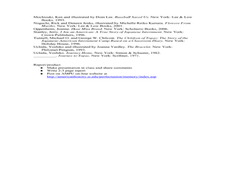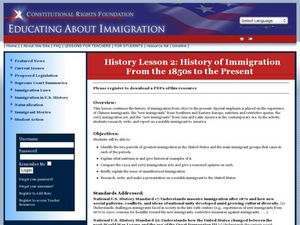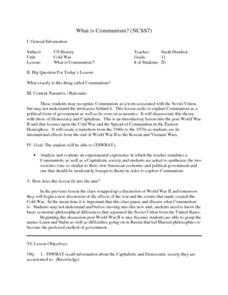National Woman's History Museum
The National Woman’s Party
Two parties led the women's suffrage movement. The National American Woman Suffrage Association (NAWSA) was a moderate organization while the National Women's Party (NWP) was more militant. Young historians investigate why members of the...
Curated OER
World War II Multimedia Newscast: History, Technology, Journalism
Students compose a multi-media newscast on various subjects relating to WWII to demonstrate their knowledge and ability to research.
Curated OER
WHERE DO I COME FROM?
Learners analyze the struggle for racial and gender equality and for the extension of civil liberties, the social and economic impact of the Great Depression, and the economic boom and social transformation of post-World War II United...
Miami-Dade County Public Schools
Veteran's Day—Honoring All That Served
Looking for ideas on ways to recognize Veteran's Day? Check out this 92-page packet that includes exercises designed for all grade levels. Reading passages detail the history of the holiday, research projects get individuals involved in...
Curated OER
Post-War Japan
Students research the conditions of post-war Japan. In groups, they examine the plans that were put into place for the country and identify the attitude of the Allies. To end the lesson, they discuss the changes that came about in their...
Curated OER
NATO Geography & Language
The class receives background information on NATO, an atlas, and a blank world map. They color the original 1949 countries in red, the 1952 additions in green, and the 1990 additions in blue. This exercise would be a good starting point...
Curated OER
From Korea to Vietnam: America Changes Her View on War
Eleventh graders identify and analyze the differences between the Korean and the Vietnam Wars. In small groups they conduct research and create a scene from a movie that focuses on the Korean or Vietnam War. Students view and evaluate...
Curated OER
Timeline of the Korean War
Students engage in a study of the Korean War by using a creative project that requires research and writing. They create a timeline of the war that can be displayed in a large or small background.
Curated OER
The White Line - A One Act Play
Students discuss amendments of the Constitution that cover due process and discuss them in relation to the play "The White Line". They determine how national security measures conflict with the issues of due process during wartime. They...
Curated OER
The End of United States' Occupation of Japan
Ninth graders examine and discuss reasons for end of U.S. occupation of Japan in 1952, locate surrounding Asian countries on map, explore changes to Japan after World War II, and discuss how changes in Japan impacted other countries.
Curated OER
Introduction to the Cold War
Students explore the correlation between the Cold War and the Domino Theory. In this history lesson, students watch a short video that exhibits the domino effect, then divide into small groups, each representing an assigned...
Curated OER
Lesson III: Crisis, Pearl Harbor, Internment
The third in a series of lessons introduced by “A Fence Away From Freedom,” uses the Smithsonian website, “A More Perfect Union: Japanese Americans and the U.S. Constitution” and focuses on the section of the presentation devoted to the...
Curated OER
Post-War Suburbanization
Students research the suburbanization of post World War II America. They identify factors aiding suburban growth and assess the degree to which it impacted American life. Students view a documentary about the benefits of...
Curated OER
Defining moments: Framing the Problem
Students create a problem framing chart to examine the issues surrounding the decision to inter Japanese Americans during World War II. They respond to a set of questions using perspectives from different parties involved in the decision...
Curated OER
"A Sound of Hammering"
Tenth graders study "A Sound of Hammering," which is a letter written by a former soldier after the Japanese surrender at the end of World War II.
Curated OER
Studying Japanese Internment with Primary Documents
Eleventh graders view photographs of the Japanese society being interned in camps during World War II in the United States. In groups, they read and discuss Executive Order 9066 and try to determine what group they are trying to focus...
Curated OER
The Japanese Empire: The Beginning
Ninth graders explore empires by researching Japan's history. In this Japanese research lesson, 9th graders discuss the history of Japan and the elements of World War II that caused Japan to become an enemy of the United States. Students...
Curated OER
Patriotism Reflected in Art and Literature (part A)
Students explore pre-World War II Japanese art. In this patriotism lesson, students analyze Eternal Fuji and Red Sun by Yokoyama Taikan. Students discuss the techniques used to create the painting as well as the symbolism behind it....
Red River Press
Remembrance Day, Lest We Forget
Have we forgotten? As part of their study of Remembrance Day, class members consider whether countries have kept their promise not to forget and create their own remembrance ceremony.
Curated OER
History of Immigration From the 1850's to the Present
Eleventh graders study the history of immigration from 1850 to the present. For this American History lesson, 11th graders compare the 1924 and 1965 immigration acts and give a reasoned opinion on each. Students research,...
Curated OER
Cartoons for the Classroom: Censorship, Silencing an Anti-War Voice
In this primary source analysis activity, students analyze political cartoons with anti-war messages and respond to 5 talking point questions.
Curated OER
What is Communism?
Eleventh graders explore Communism. They explore Communism's roots in economics and discuss the spread of Communism in the Eastern Hemisphere. They evaluate a Communistic and a Capitalistic society. Students reflect upon the positives...
EngageNY
Gathering Textual Evidence: “Invisibility” of Those Interned
Add another layer to the class's understanding. Scholars deepen their knowledge of the primary sources in their Japanese-American Internment during World War II packet and determine how the sources relate to the theme of invisibility....
Curated OER
Studying Oral Histories
Pupils read stories from the 1930s and 1940s. They discuss homelife during World War II. students examine changes in lifestyle and technology that may take place in the future.
Other popular searches
- Post World War Ii
- Post World War Ii Asia
- Post World War Ii Europe
- Post World War Ii
- Post World War Ii America
- Post World War I Art
- Post World War Ii Era
- Post World War Ii People























